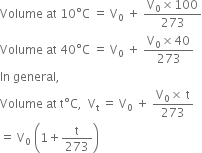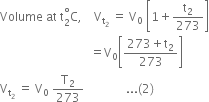 Long Answer Type
Long Answer TypeCharle's law states: Pressure remaining constant the volume of a given mass of gas increases or decreases by  volume at
volume at  for each one-degree rise or fall in temperature.
for each one-degree rise or fall in temperature.
Mathematically,
If V0 is the volume at 0°C, then the volume at various other temperatures can be written as:

But if the gas is cooled to –273°C, then its volume becomes zero.
This implies that a gas at -273°C will have zero or no volume i.e. it will cease to exist. In actual practice, all gases liquefy before this temperature is reached. Also –273°C should be the lowest possible temperature because any further cooling would lead to a volume of less than zero or negative volume which is meaningless. Therefore, this temperature (–273° C) was termed as absolute zero of temperature.
Another statement of Charle’s law:
According to Charle’s law, volume of a given mass of a gas at different temperatures is related to its volume (V0) at 0°C as follows:
Volume at 


Dividing (1) by (2), we get,

[Pressure and mass of the gas constant]
Hence Charle’s law may also be stated as Pressure remaining constant, the volume of a given mass of a gas is directly proportional to absolute temperature i.e. 
Thus, if V1 is the initial volume of the gas at temperature T1 (in degree kelvin) and V2 is the final volume of the gas at temperature T2 (in degree kelvin), keeping pressure constant, then
How will you verify Charle's law graphically? What is the practical importance of Charle's law?
 Short Answer Type
Short Answer Type Long Answer Type
Long Answer Type Short Answer Type
Short Answer TypeA sample of helium gas has a volume of 500 cm3 at 373K. Calculate the temperature at which the volume becomes 260 cm3. Assume that the pressure is kept constant.
On a ship sailing in Pacific ocean where the temperature is 23.4 °C, a balloon is filled with 2L air. What will be the volume of the balloon when the ship reaches Indian ocean, where the temperature is 26.1°C ?
A cylinder contains 450 mL of a gas at 27°C at constant pressure. The cylinder is placed in a refrigerator at –10°C. Calculate the resultant volume of the gas.
What volume of air will be expelled from a vessel containing 380 cm3 at 10°C when it is heated to 30°C at the same pressure ?
 Long Answer Type
Long Answer TypeA student forgot to add the reaction mixture to the round bottomed flask at 27°C but instead he/she placed the flask on the flame. After a lapse of time, he realized his mistake, and using a pyrometer he found that the temperature of the flask was 477°C. What fraction of air would have been expelled out?
